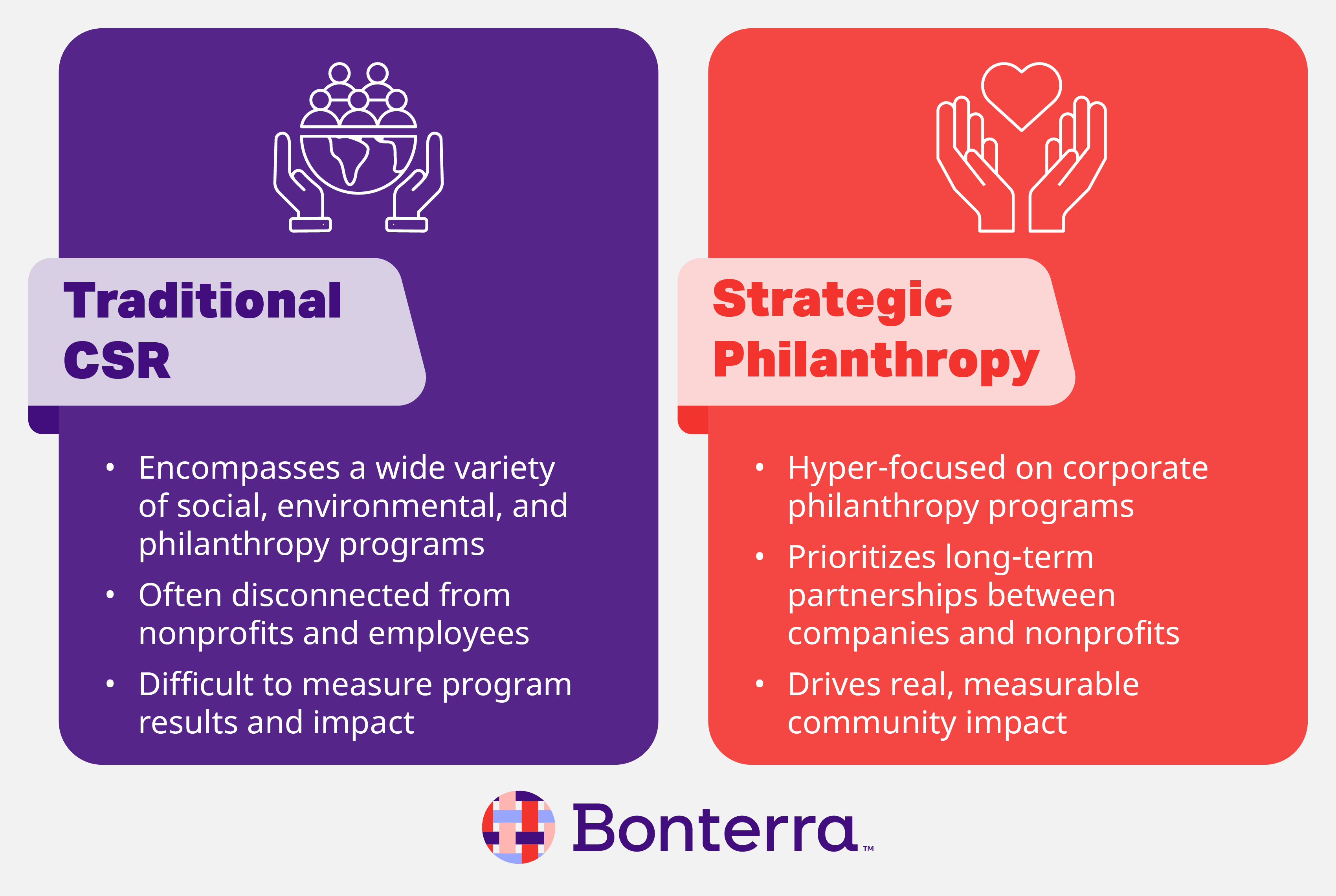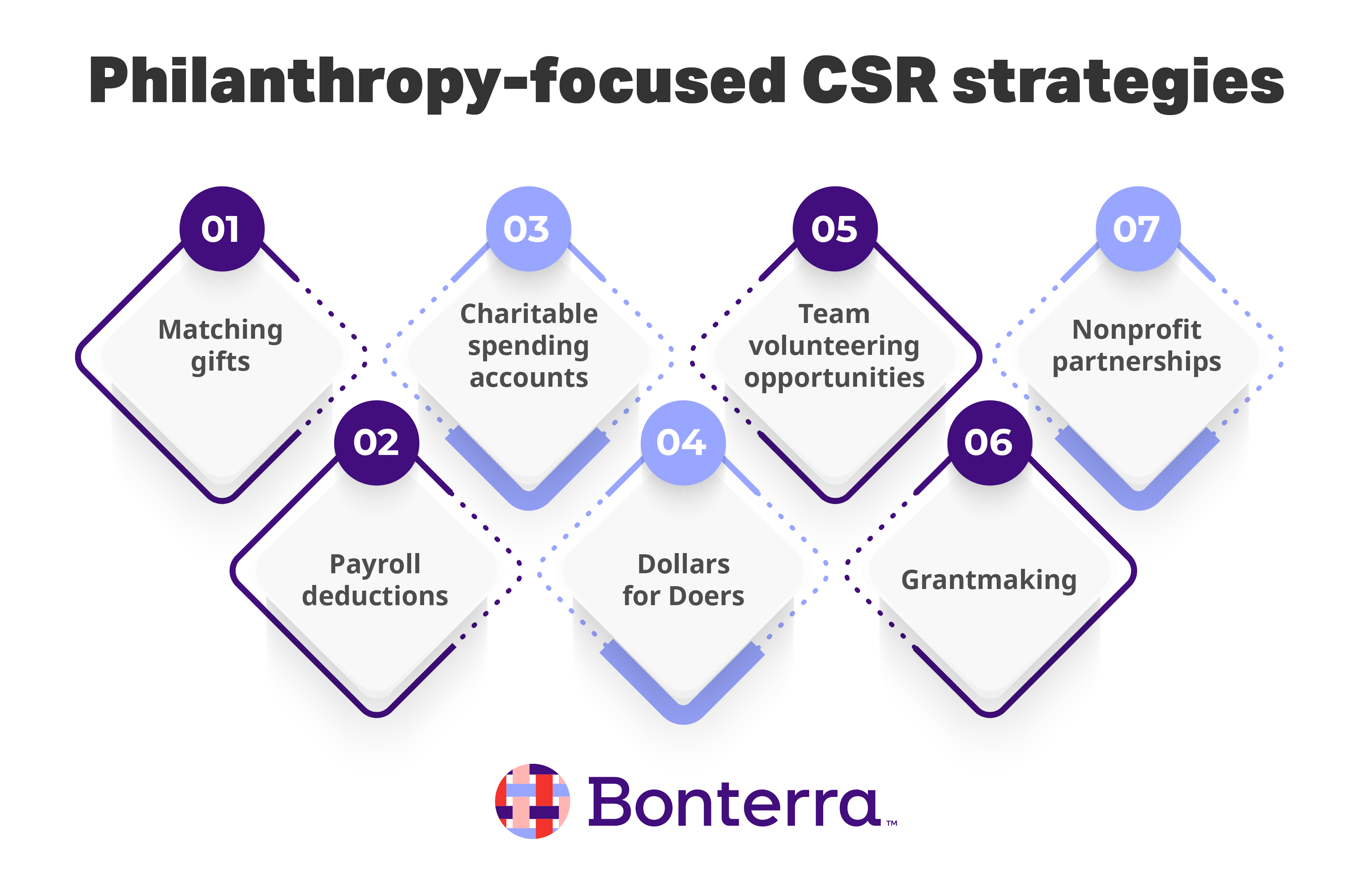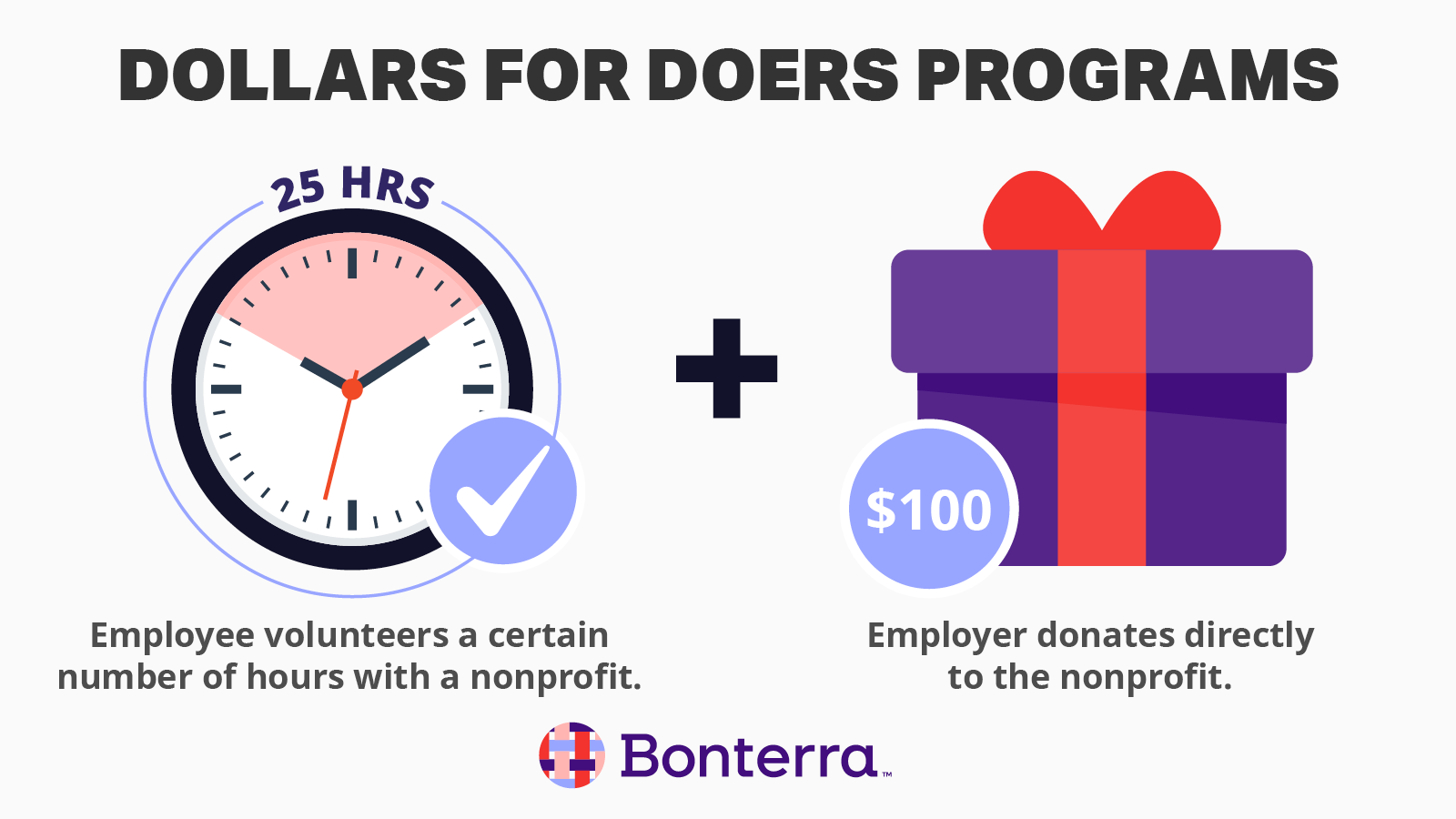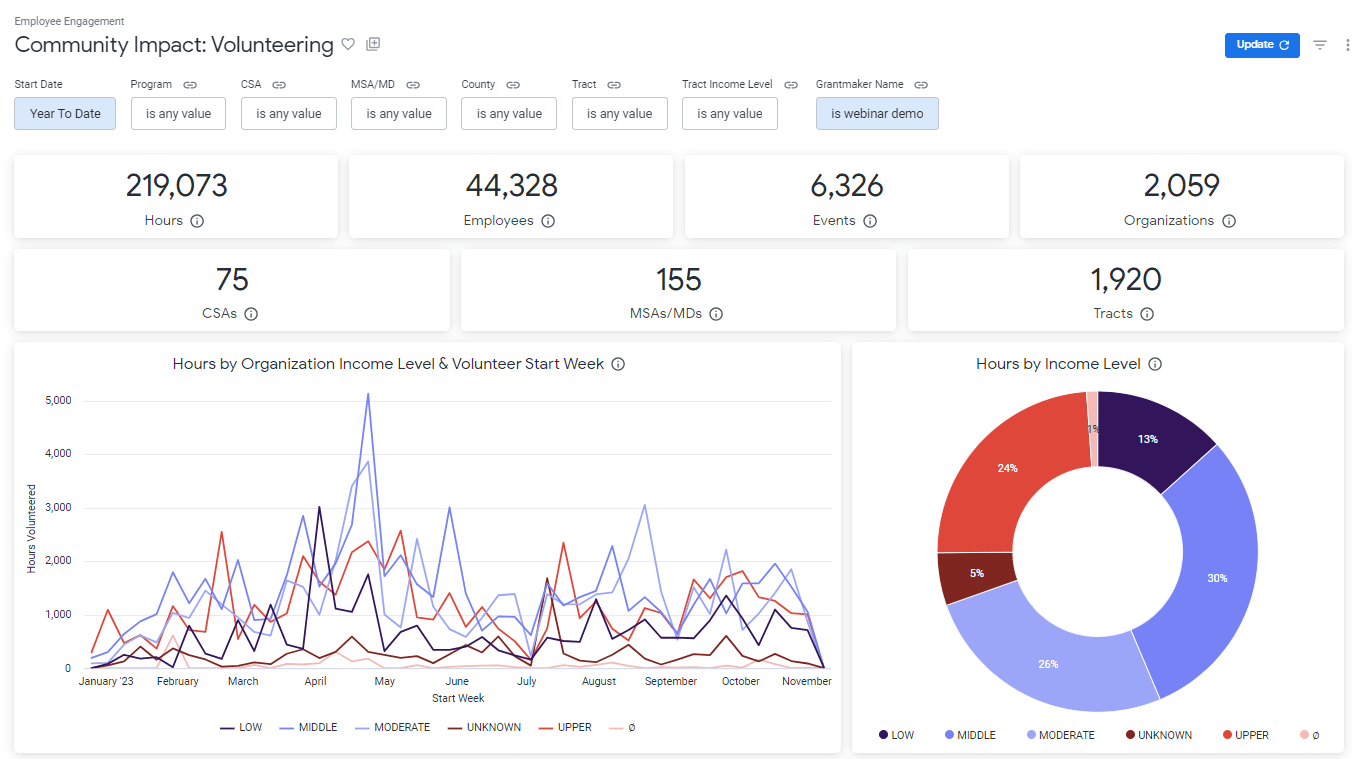In the past few years, corporate social responsibility (CSR) software has become more and more of a priority for employees and employers alike. Approximately 70% of Americans believe it’s either “somewhat important” or “very important” for corporations to make a positive social impact, and corporations need a framework for delivering and measuring this impact.
That’s where dedicated CSR strategies come into play. Ranging from volunteerism to matching gifts and beyond, these programs help businesses engage employees and appeal to evolving stakeholder priorities to set themselves up for long-term success.



 Then, strategically communicate your programs’ impact to employees and other stakeholders. Share concrete numbers and facts along with:
Then, strategically communicate your programs’ impact to employees and other stakeholders. Share concrete numbers and facts along with:
What is a CSR strategy?
A CSR strategy is your company’s approach to corporate social responsibility, including the philanthropy programs you offer and how you plan to involve employees in your efforts. By developing thoughtful CSR strategies, you’ll be better equipped to create impact, engage employees, and report on your success.CSR vs. strategic philanthropy
When developing a CSR strategy for your business, you might consider traditional approaches that try to address everything from sustainability to company culture to social justice. Rather than spreading your efforts too thin, however, we recommend zeroing in on the one aspect of CSR that makes the most impact: strategic philanthropy. The main differences between traditional CSR strategies and our vision of strategic philanthropy can be broken down like this:
- Traditional CSR: encompasses a wide variety of social, environmental, and philanthropy programs. These strategies are often disconnected from nonprofit organizations and employees alike. Furthermore, it can be difficult to measure program results and impact in concrete terms.
- Strategic philanthropy: is hyper-focused on corporate philanthropy programs, prioritizing long-term partnerships between companies and nonprofits that drive real, measurable community impact through donations and volunteer hours.
7 philanthropy-focused CSR strategies to drive impact
Start tapping into strategic philanthropy by implementing one or more of these philanthropy-focused types of CSR strategies:
Matching gifts
Through a matching gift program, your company helps employees give to the causes they care about by financially matching their donations. This usually occurs at a 1:1 ratio, meaning that you would match an employee’s $100 gift with another $100 from your company. However, your business can set its own guidelines for match ratios and donation eligibility depending on your resources and the causes you want to support. To accommodate the wide range of causes your employees care about, consider an open matching gift program that allows employees to choose which nonprofits they support instead of limiting their options. Matching gift programs are one of the top CSR strategies because they’re straightforward, easy to implement, and employee-led. Plus, they generate a clear positive impact that you can measure by the total funds your company donates through matching gifts.Payroll deductions
To encourage participation in your workplace giving programs, it’s important to provide as much convenience for employees as possible. Automatic payroll deductions are an especially effortless way for employees to give, as this CSR strategy allows employees to donate a certain amount from their paychecks directly to an organization of their choice. If interested, employees can even set up payroll deductions to occur on a monthly or biweekly basis, allowing them to become recurring donors to their favorite nonprofits without any extra work on their part.Charitable spending accounts
Rather than asking employees to donate out of their own paychecks, some companies offer charitable spending accounts (CSAs) or stipends. This CSR strategy provides individual employees with a specific budget, such as $50 or $100, that they can donate to the nonprofit of their choice. When implementing this strategy, set clear eligibility criteria for which employees qualify for these accounts. For instance, you might make CSAs available only to full-time employees who have been at the business for at least a year.Dollars for Doers
Starting a Dollars for Doers program (also called D4D or volunteer grants) allows your business to make an impact through both volunteer hours and donations. Here’s how it works:
- An employee volunteers with an eligible nonprofit for a certain amount of time, such as 25 hours
- The employee logs their hours and submits a request for a Dollars for Doers grant
- If the request meets your requirements, your company donates directly to the nonprofit the employee volunteered with
Team volunteering opportunities
Engage employees and improve team-building with a team volunteering day. To organize one of these events, research local nonprofits that need volunteers and find an opportunity that a large group of employees can participate in together. Then, schedule a day during or outside of work hours and watch your team grow closer through volunteering. Don’t forget to take photos and videos to share with stakeholders and the public to demonstrate your company’s commitment to philanthropy.Grantmaking
While grantmaking is less hands-on for employees than other CSR strategies, it allows your business to make a larger, more direct impact on specific nonprofits. Instead of asking your employees to donate or volunteer, your company invites nonprofits themselves to apply for a corporate grant. Once approved, you’ll award a grant directly to the nonprofit and receive clear reports about the grant’s usage and impact.Nonprofit partnerships
This strategy is at the heart of our vision for strategic philanthropy. When companies and nonprofits join together to further social good, they achieve better outcomes than either organization could alone. All of the above CSR strategies can help you form relationships with nonprofits, but it’s up to your business to maintain those connections and turn them into mutually beneficial partnerships. Note which nonprofits your employees donate to and volunteer with the most, and build relationships with those organizations if they align with your company values. Invite them to apply for your grants, organize a company-wide volunteer day with them, or offer to sponsor one of their fundraising events. Most importantly, have conversations with nonprofit leadership about what their needs are and how your company can help them create a more meaningful impact.Developing a CSR strategy for your company: 3 steps
While it’s up to your company to decide how you’ll incorporate these programs into an overall CSR strategy that aligns with your goals and priorities, you can use these basic steps to guide your approach.1. Get leadership buy-in
To make philanthropy programs effective, the entire company has to believe in and adopt the initiative. This means securing leadership buy-in early on in the planning process and making sure key decision-makers are on the same page about your CSR strategies. Bridge any knowledge gaps and explain to stakeholders why your company should invest in strategic philanthropy. Then, work together to set attainable, measurable goals for your CSR strategies and implement consistent reporting frameworks.2. Choose value-aligned CSR strategies to focus on
Since there is so much that corporations can do regarding philanthropy, it’s important to focus on the areas where your company can make a measurable difference. Consider value-aligned strategies that will interest employees and achieve the maximum impact within the community. Employees are most likely to support your philanthropy if they’re invested in the cause. Ask for their input when choosing CSR strategies, and prioritize programs and cause areas that resonate most with employees. Solicit their feedback by:- Sending out an open-ended employee survey
- Organizing a meeting about the vision for your philanthropy programs and how employees will benefit
- Scheduling a manager meeting to brainstorm ways to motivate employee participation
3. Maintain transparent and consistent impact reporting
Ensure the long-term success of your company’s CSR strategies by determining the most relevant metrics according to your goals and stakeholder opinions. Then, by collecting accurate data and developing a consistent reporting framework, you’ll lay a solid foundation for communicating impact moving forward. Simplify the reporting process by leveraging specialized CSR software like Bonterra Strategic Philanthropy. This tool helps you track, visualize, and easily report on key impact metrics like hours volunteered and funds donated. Then, strategically communicate your programs’ impact to employees and other stakeholders. Share concrete numbers and facts along with:
Then, strategically communicate your programs’ impact to employees and other stakeholders. Share concrete numbers and facts along with:
- Stories of the people your company helped: For instance, you might share thank-you notes your company received from previous projects to show employees the direct impact their participation has on nonprofits’ beneficiaries.
- Diverse content across multiple avenues of communication: Share photos and infographics alongside stories of your impact to bring your reports to life.
Getting started with your CSR strategies
A well-thought-out CSR strategy can go a long way toward building more meaningful and positive relationships with your company’s stakeholders, customers, and community members. As with any initiative, remember to regularly evaluate your results to identify insights that will help you improve your efforts over time and stay at the forefront of strategic philanthropy. Additionally, make employees feel valued by showing your appreciation for those who participate in your programs.
Ready to implement CSR strategies that deliver real impact?




